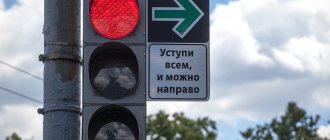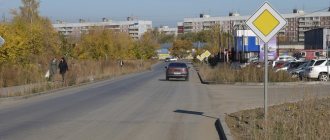Good afternoon, dear reader.
This article discusses the rules for pedestrians regulating the issues of crossing the roadway. You will learn how to cross the road correctly and what you need to pay attention to when doing so.
Let me remind you that in the previous article we talked about choosing the right place to cross the roadway. However, choosing a location is only half the battle. The other half is the correct behavior of a pedestrian when crossing the road. After all, correct behavior is the key to pedestrian safety.
Signalized intersection and signalized crossing
Let's turn to clause 4.4 of the traffic rules:
4.4. In places where traffic is regulated, pedestrians must be guided by the signals of a traffic controller or a pedestrian traffic light, and in its absence, a transport traffic light.
A pedestrian crossing or intersection is controlled only if the traffic is regulated by a traffic controller (police officer) or a working traffic light.
Please note that if the yellow signal is constantly flashing at the traffic light, then such an intersection is uncontrolled.
Traffic controller signals for pedestrians
The traffic controller automatically turns any intersection into a regulated one. If there is a traffic controller at the intersection, then you need to be guided by his gestures, and not by the traffic lights!
The rules provide for 3 possible traffic controller gestures:
| Gesture | Pedestrian implications |
| right hand raised above head | No Pedestrians |
| right arm extended forward | Pedestrian movement is permitted from behind the traffic controller |
| arms extended in different directions in the shape of the letter T | Pedestrian movement is permitted from the chest and from the back of the traffic controller |
Let's look at a few examples.
In the figure, the right hand of the traffic controller is extended forward, therefore pedestrians can only cross the road from the side of the policeman’s back.
Please note that this gesture allows the red car to turn right, i.e. the trajectories of the pedestrian and the car intersect. In this case, the car must give way (clause 13.1 of the Rules). However, the pedestrian should be careful, because... the driver may not know the rules or simply not notice the pedestrian.
In the figure, the traffic controller’s arms are extended to the sides, i.e. Pedestrians are allowed to move from both the chest and the back.
At the same time, both orange and blue cars have the right to turn right, giving way to pedestrians. So be careful.
Since many pedestrians do not know the traffic controller’s gestures, police officers in practice can use additional gestures. For example, they allow pedestrians to move by simply waving their hand in the right direction.
At what traffic light can you cross the road?
A traffic light at an intersection makes the intersection controllable only if it operates in the red-amber-green mode (and not in the flashing yellow signal mode).
A special pedestrian traffic light , on which there are images of little men, allows the movement of pedestrians if the traffic light is green, and prohibits it if the traffic light is red. Crossing a red light is a violation of traffic rules, for which a pedestrian may be subject to an administrative fine.
If at an intersection there is only a car traffic light and no pedestrian traffic light, then you need to be guided by the signals of the car traffic light. But how to be guided is not specified in the rules.
Therefore, everything is left to the discretion of the pedestrian. Some pedestrians cross the road when the signal in the right direction is green, while others cross when the signal for all cars is red. In general, the situation is controversial, so be careful. Fortunately, there are fewer and fewer such intersections over time.
Rules for crossing a regulated pedestrian crossing
A controlled crossing or intersection is understood as the place on the road where there is a traffic light or a traffic controller stands. It can automatically become unregulated if the traffic light has a yellow signal all the time (more precisely, it blinks at constant intervals).
In cases where a working traffic light is installed at an intersection and at the same time there is a traffic controller, the pedestrian should be guided not by the traffic light and the signals it gives, but by the traffic controller’s gestures. The most important gestures for you and me are the following:
- arms are extended with the letter T in different directions - passage is allowed from the back and chest of the person who regulates the movement;
- right arm extended forward - movement only from the back;
- the right hand raised above the head is a ban on crossing the intersection.
When at a controlled intersection there is no special two-section traffic light for pedestrians (green and red), a person can be guided by the traffic light signals for drivers (it already has three sections). Passing through the red signal of any traffic light is strictly prohibited. For this, the pedestrian is subject to a fine.
Unregulated pedestrian crossing
Clause 4.5 of the traffic rules:
4.5. At unregulated pedestrian crossings, pedestrians can enter the roadway (tram tracks) after assessing the distance to approaching vehicles, their speed and making sure that the crossing will be safe for them. When crossing the road outside a pedestrian crossing, pedestrians, in addition, must not interfere with the movement of vehicles and exit from behind a standing vehicle or other obstacle that limits visibility without making sure that there are no approaching vehicles.
At unregulated crossings, the rules for pedestrians are strict but fair - you should your own traffic safety
Please note that you should not throw yourself directly under the wheels of oncoming vehicles, as many pedestrians do.
How to cross the road correctly
Section No. 4 of the traffic rules stipulates that crossing the road is allowed only in strictly designated areas, according to designated markings. If for some reason there is not one, then at intersections you need to move along the curb and sidewalk.
Pedestrian crossing is a designated area on/under/above the road for safe walking. The transition is indicated by signs, which are represented as a blue rectangle. It has a white triangle with a little man moving along the markings. This sign is located on the left and right sides.
In addition to the above signs, it is indicated by “zebra” or “zebra” markings with arrows. Zebra markings with arrows are located in those areas where the width of the crossing is larger than the standard dimensions. There may or may not be markings, but the transition itself can be limited only by the corresponding signs.
If there are no pedestrian crossings or intersections in nearby areas, then the road is crossed in a place where all sections of the road are clearly visible and there are no dividing lines or fences. According to the rules, movement is carried out at right angles.
When the crossing is not regulated in any way, then before crossing the road, it is necessary to make sure that there is no approaching traffic, as well as those vehicles traveling at high speed.
How to cross the road if there is no crossing?
When crossing the road outside the crossing, you need to be even more attentive to the issue of safety. At the same time, you cannot go out onto the roadway because of parked cars. It is also prohibited to interfere with the movement of vehicles, i.e. Outside a pedestrian crossing, you should cross the road at a considerable distance from approaching vehicles.
In most cases, when an accident occurs with a pedestrian outside a pedestrian crossing, the pedestrian is at fault. Those. In addition to the fact that the pedestrian may suffer physically, he will also suffer financially, because the culprit of the accident pays for the repair of the damaged vehicle and other damage.
How to cross the road correctly?
Clause 4.6 of the rules regulates behavior when crossing the road:
4.6. Once on the roadway (tram tracks), pedestrians should not linger or stop unless this is related to ensuring traffic safety. Pedestrians who do not have time to complete the crossing must stop on the line dividing traffic flows in opposite directions. You can continue crossing only after making sure that further movement is safe and taking into account the traffic light signal (traffic controller).
Traffic regulations prohibit a pedestrian from stopping on the roadway, except in cases where this is related to ensuring traffic safety.
For example, if you start walking along a crossing, but notice a car moving at high speed in the next lane, you can stop.
However, I highly recommend stopping on the roadway unnecessarily, because... the driver may not be ready for such a “maneuver” and allow a collision.
The rules allow stopping on the line dividing traffic flows in opposite directions. However, this should be avoided on busy roads. It is better to calculate your own strength in advance, choose a convenient moment and cover the entire width of the roadway in one go.
I will also note that the line dividing traffic flows in opposite directions is some imaginary line that you are asked to determine yourself.
When is it prohibited to go out onto the roadway?
Paragraph 4.7 of the traffic rules:
4.7. When approaching vehicles with a blue flashing light (blue and red) and a special sound signal on, pedestrians are required to refrain from crossing the road, and pedestrians on the roadway (tram tracks) must immediately vacate the roadway (tram tracks).
The rules prohibit entering the road in front of special service vehicles that have both flashing lights and sound signals on:
Please note that if a pedestrian has the right of way (walking along the crossing), then he must give way only to a car with the sound signal on .
If the driver turns on the flashing lights, but does not turn on the siren, then pedestrians are not obliged to give way to him. However, you shouldn’t deliberately throw yourself under the wheels. A pedestrian on the road risks life and health, so it is better to let the offender’s car pass once again than to end up in the hospital.
In practice, I recommend not throwing yourself under the wheels not only of cars with special signals, but also of all other cars. Unfortunately, a pedestrian’s chances of surviving an accident with a car traveling at a speed of 50–60 km/h are slim.
When not to go out on the road
Except for cases of crossing the roadway at a prohibiting traffic light, it is prohibited to go out onto the road:
- in places where a dividing fence is installed in the middle of the road or a dividing strip is applied;
- when the view is blocked;
- when the roadway is separated from the sidewalk by a fence.
According to the rules, you cannot cross the road when there is a controlled crossing or intersection within your line of sight. You need to get to it and only then cross the roadway.
You cannot cross the road even when the light is green if a car is approaching with its sound signals and flashing lights on (ambulance, fire, police).
Fines for pedestrians at crossings
Fines for pedestrians are given in Articles 12.29 and 12.30 of the Code of Administrative Offenses:
| Violation | Punishment |
| Violation of rules by a pedestrian | warning or 500 rubles |
| Violation of rules resulting in obstruction of traffic or harm to health | 1,000 rubles |
Thus, both for crossing a red light and for jaywalking, a pedestrian can be punished with only a small fine.
Well, the next article discusses the rules for waiting for route vehicles.
Good luck on the roads!








